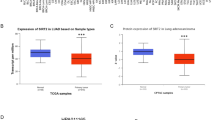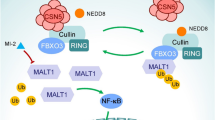Abstract
Lung cancer is still a main cause of cancer-related death worldwide. Non-small-cell lung cancer (NSCLC) accounts for the majority of lung cancers, and gefitinib is an effective targeted drug for NSCLC. It is important to explore the underlying molecular mechanisms of gefitinib resistance to provide new treatment strategies and to improve the prognosis of gefitinib-resistant NSCLC patients. This study aimed to examine the role of filamin A (FLNA) in acquired resistance to gefitinib in NSCLC, and identify ANXA2 (annexin A2), one of calcium-dependent phospholipid-binding proteins, as its corresponding regulatory factor. First, we established resistant cells via long-term exposure to gefitinib to analyse the association between FLNA and gefitinib resistance. Through quantitative real-time polymerase chain reaction (qRT-PCR), Cell Counting Kit-8 (CCK-8), western blotting (WB), and flow cytometry assays, we evaluated the role of FLNA. The effect of FLNA knockdown or overexpression was analysed not only in cell lines but also in mouse models. We verified the FLNA-interacting protein through coimmunoprecipitation (CoIP) experiments and found that the downstream signalling pathway was regulated by FLNA and its interacting protein. Finally, the upstream transcription factor was identified by chromatin immunoprecipitation (ChIP). Increased FLNA expression induced gefitinib resistance. Knockdown of FLNA restored gefitinib sensitivity and induced apoptosis in vivo and in vitro. FLNA and ANXA2 cooperatively led to the activation of the Wnt pathway, which was closely linked to gefitinib resistance. Subsequently, SP1 promoted transcriptional activation of FLNA to regulate gefitinib resistance. We determined that FLNA serves as a regulator of gefitinib resistance in NSCLC and found that FLNA and ANXA2 together induced gefitinib resistance by activating the Wnt pathway.







Similar content being viewed by others
References
Stewart EL, Tan SZ, Liu G, Tsao MS (2014) Known and putative mechanisms of resistance to EGFR targeted therapies in NSCLC patients with EGFR mutations-a review. Transl Lung Cancer Res 4:67–81
Pao W, Wang TY, Riely GJ, Miller VA, Pan Q, Ladanyi M et al (2005) KRAS mutations and primary resistance of lung adenocarcinomas to gefitinib or erlotinib. PLoS Med 2:e17
Zhou AX, Hartwig JH, Akyurek LM (2009) Filamins in cell signaling, transcription and organ development. Trends Cell Biol 12:113–123
Nallapalli RK, Ibrahim MF, Zhou AX, Bandaru SF, Sunkara SF, Redfors BF et al (2012) Targeting filamin A reduces K-RAS-induced lung adenocarcinomas and endothelial response to tumor growth in mice. Mol Cancer 11:50
Vitali E, Boemi I, Rosso L, Cambiaghi V, Novellis P, Mantovani G et al (2017) FLNA is implicated in pulmonary neuroendocrine tumors aggressiveness and progression. Oncotarget 8:77330–77340
Wang K, Zhu TN, Zhao RJ (2019) Filamin A regulates EGFR/ERK/Akt signaling and affects colorectal cancer cell growth and migration. Mol Med Rep 20:3671–3678
Zhang K, Zhou TF, Gao DF, Zhang TF, Zhao QF, Liu SF et al (2014) Filamin A expression correlates with proliferation and invasive properties of human metastatic melanoma tumors: implications for survival in patients. J Cancer Res Clin Oncol 140:1913–1926
Guo Y, Li M, Bai G, Li X, Sun Z, Yang J et al (2018) Filamin A inhibits tumor progression through regulating BRCA1 expression in human breast cancer. Oncol Lett 16:6261–6266
Kpetemey M, Dasgupta S, Rajendiran S, Das S, Gibbs LD, Shetty P et al (2015) MIEN1, a novel interactor of Annexin A2, promotes tumor cell migration by enhancing AnxA2 cell surface expression. Mol Cancer 14:156
Grindheim AK, Saraste J, Vedeler A (2017) Protein phosphorylation and its role in the regulation of Annexin A2 function. Biochim Biophys Acta Gen Subj 1861:2515–2529
Bøtkjær JA, Jeppesen JV, Wissing ML, Kløverpris S, Oxvig C, Mason J et al (2015) Pregnancy-associated plasma protein A in human ovarian follicles and its association with intrafollicular hormone levels. Fertil Steril 104:1294–1301
Gatti V, Fierro C, Compagnone M, Giangrazi F, Market EK, Bongiorno BL et al (2018) ΔNp63 regulates the expression of hyaluronic acid-related genes in breast cancer cells. Oncogenesis 7:65
Li Y, Friedmann DR, Mhatre AN, Lalwani AK (2008) MYH9-siRNA and MYH9 mutant alleles: expression in cultured cell lines and their effects upon cell structure and function. Cell Motil Cytoskeleton 65:393–405
Chen CY, Lin YS, Chen CL, Chao PZ, Chiou JF, Kuo CC et al (2015) Targeting annexin A2 reduces tumorigenesis and therapeutic resistance of nasopharyngeal carcinoma. Oncotarget 6:26946–26959
Mingione A, Verdelli C, Ferrero S, Vaira V, Guarnieri V, Scillitani A et al (2017) Filamin A is reduced and contributes to the CASR sensitivity in human parathyroid tumors. J Mol Endocrinol 58:91–103
Bedolla RG, Wang Y, Asuncion A, Chamie K, Siddiqui S, Mudryj MM et al (2009) Nuclear versus cytoplasmic localization of filamin A in prostate cancer: immunohistochemical correlation with metastases. Clin Cancer Res 15:788–796
Gachechiladze MF, Skarda J, Janikova MF, Mgebrishvili GF, Kharaishvilli GF, Kolek VF et al (2016) Overexpression of filamin-A protein is associated with aggressive phenotype and poor survival outcomes in NSCLC patients treated with platinum-based combination chemotherapy. Neoplasma 63:274–281
Zhang Y, Zhu T, Liu J, Liu J, Gao D, Su T et al (2018) FLNa negatively regulated proliferation and metastasis in lung adenocarcinoma A549 cells via suppression of EGFR. Acta Biochim Biophys Sin 50:164–170
**ng X, Yuan H, Sun Y, Ke K, Dong X, Chen H et al (2019) ANXA2(Tyr23) and FLNA(Ser2152) phosphorylation associate with poor prognosis in hepatic carcinoma revealed by quantitative phosphoproteomics analysis. J Proteomics 200:111–122
Yi Y, Zeng S, Wang Z, Wu M, Ma Y, Ye X et al (2018) Cancer-associated fibroblasts promote epithelial-mesenchymal transition and EGFR-TKI resistance of non-small cell lung cancers via HGF/IGF-1/ANXA2 signaling. Biochim Biophys Acta Mol Basis Dis 1864:793–803
Feng X, Liu H, Zhang Z, Gu Y, Qiu H, He Z (2017) Annexin A2 contributes to cisplatin resistance by activation of JNK-p53 pathway in non-small cell lung cancer cells. J Exp Clin Cancer Res 36:123
Alves RD, Eijken MF, Swagemakers SF, Chiba HF, Titulaer MF, Burgers PF et al (2010) Proteomic analysis of human osteoblastic cells: relevant proteins and functional categories for differentiation. J Proteome Res 9:4688–4700
Tammela T, Sanchez-Rivera FJ, Cetinbas NM, Wu K, Joshi NS, Helenius K et al (2017) A Wnt-producing niche drives proliferative potential and progression in lung adenocarcinoma. Nature 545:355–359
Park J, Cho YH, Shin WJ, Lee SK, Lee J, Kim T et al (2019) A Ras destabilizer KYA1797K overcomes the resistance of EGFR tyrosine kinase inhibitor in KRAS-mutated non-small cell lung cancer. Sci Rep 9:648–648
Botting GM, Rastogi I, Chhabra G, Nlend M, Puri N (2015) Mechanism of resistance and novel targets mediating resistance to EGFR and c-met tyrosine kinase inhibitors in non-small cell lung cancer. PLoS ONE 10:e0136155
Nakata A, Yoshida R, Yamaguchi R, Yamauchi M, Tamada Y, Fuiita A et al (2015) Elevated β-catenin pathway as a novel target for patients with resistance to EGF receptor targeting drugs. Sci Rep 5:13076
Wang J, Zhou P, Wang XD, Yu YX, Zhu GK, Zheng LP et al (2019) Rab25 promotes erlotinib resistance by activating the β1 integrin/AKT/β-catenin pathway in NSCLC. Cell Prolif 52:e12592
Wu J, Tang Q, Ren X, Zheng F, He C, Chai X et al (2019) Reciprocal interaction of HOTAIR and SP1 together enhance the ability of **aoji decoction and gefitinib to inhibit EP4 expression. J Ethnopharmacol 237:128–140
Author information
Authors and Affiliations
Contributions
LC collection of the data and writing of the manuscript; QT conception and design.
Corresponding author
Ethics declarations
Conflict of interest
The authors declare that there are no conflicts of interest.
Ethical approval
The study was approved by the Ethics Committee of Guangdong Medical Experimental Animal Care.
Additional information
Publisher's Note
Springer Nature remains neutral with regard to jurisdictional claims in published maps and institutional affiliations.
Supplementary Information
Below is the link to the electronic supplementary material.
Rights and permissions
About this article
Cite this article
Cheng, L., Tong, Q. Interaction of FLNA and ANXA2 promotes gefitinib resistance by activating the Wnt pathway in non-small-cell lung cancer. Mol Cell Biochem 476, 3563–3575 (2021). https://doi.org/10.1007/s11010-021-04179-1
Received:
Accepted:
Published:
Issue Date:
DOI: https://doi.org/10.1007/s11010-021-04179-1




